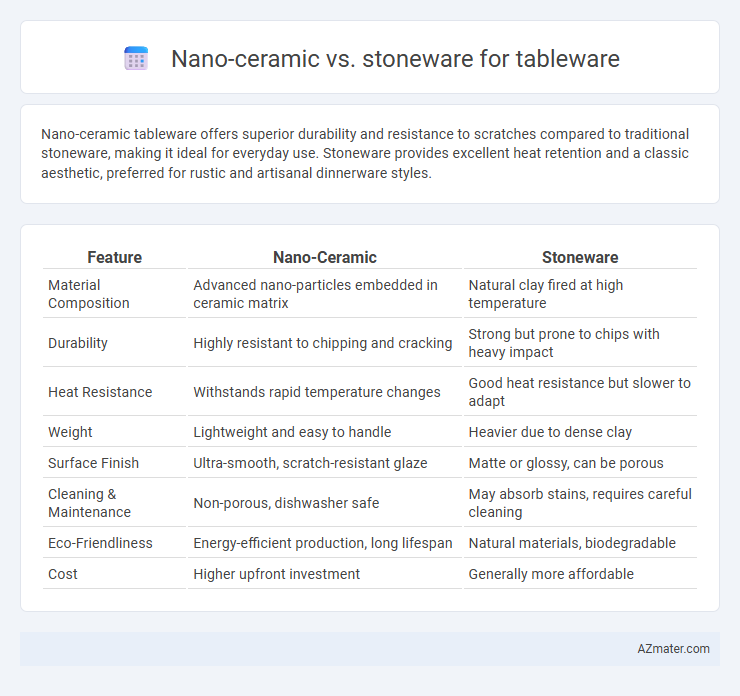Nano-ceramic tableware offers superior durability and resistance to scratches compared to traditional stoneware, making it ideal for everyday use. Stoneware provides excellent heat retention and a classic aesthetic, preferred for rustic and artisanal dinnerware styles.
Table of Comparison
| Feature | Nano-Ceramic | Stoneware |
|---|---|---|
| Material Composition | Advanced nano-particles embedded in ceramic matrix | Natural clay fired at high temperature |
| Durability | Highly resistant to chipping and cracking | Strong but prone to chips with heavy impact |
| Heat Resistance | Withstands rapid temperature changes | Good heat resistance but slower to adapt |
| Weight | Lightweight and easy to handle | Heavier due to dense clay |
| Surface Finish | Ultra-smooth, scratch-resistant glaze | Matte or glossy, can be porous |
| Cleaning & Maintenance | Non-porous, dishwasher safe | May absorb stains, requires careful cleaning |
| Eco-Friendliness | Energy-efficient production, long lifespan | Natural materials, biodegradable |
| Cost | Higher upfront investment | Generally more affordable |
Introduction to Nano-Ceramic and Stoneware Tableware
Nano-ceramic tableware features a durable, non-porous surface engineered with nanoparticles for enhanced scratch resistance and stain repellency. Stoneware tableware is crafted from dense clay fired at high temperatures, offering robust durability and a rustic, earthy aesthetic. Both materials provide excellent heat retention and are dishwasher safe, making them practical choices for everyday dining.
Material Composition and Manufacturing Process
Nano-ceramic tableware is crafted using advanced nanotechnology that integrates nanoparticles into the ceramic matrix, resulting in enhanced strength, scratch resistance, and thermal stability. Stoneware, composed primarily of dense clay fired at high temperatures between 1,100degC and 1,300degC, offers robust durability and natural, rustic aesthetics due to its vitrified, non-porous surface. The manufacturing process of nano-ceramics involves precise control of nanoparticle dispersion and high-temperature sintering techniques, whereas stoneware is traditionally molded and subjected to kiln firing, emphasizing traditional craftsmanship.
Durability and Strength Comparison
Nano-ceramic tableware features advanced nanomaterials that enhance resistance to chipping and cracking, making it significantly more durable than traditional stoneware. Stoneware offers substantial strength and heat retention but is generally more prone to impact damage and surface scratches compared to nano-ceramic options. The nano-ceramic composition also provides superior flexibility and toughness, ensuring longer-lasting performance in everyday use.
Aesthetic Appeal and Design Versatility
Nano-ceramic tableware offers a sleek, modern aesthetic with a smooth, glass-like finish that enhances vibrant colors and intricate patterns, making it ideal for contemporary and minimalist settings. Stoneware provides a rustic, earthy appeal with natural textures and muted tones that complement traditional and farmhouse designs. The design versatility of nano-ceramics allows for more precise shapes and fine detailing, while stoneware excels in durability and organic, handcrafted looks.
Heat Resistance and Thermal Performance
Nano-ceramic tableware offers superior heat resistance with the ability to withstand rapid temperature changes up to 800degC without cracking, making it ideal for both microwave and oven use. Stoneware exhibits excellent thermal performance by retaining heat evenly and releasing it slowly, maintaining food warmth longer but is more prone to thermal shock under sudden temperature fluctuations. The choice between nano-ceramic and stoneware depends on the cookware's intended use, balancing nano-ceramic's durability in high heat environments with stoneware's heat retention qualities.
Safety and Food Compatibility
Nano-ceramic tableware offers superior safety due to its non-porous surface that resists bacteria absorption, making it highly hygienic and ideal for food contact. Stoneware, while durable and heat-resistant, can be more porous unless properly glazed, potentially harboring bacteria if the glaze is compromised. Both materials are food-safe when manufactured to standards, but nano-ceramic's advanced coating enhances chemical resistance and reduces the risk of leaching harmful substances during use.
Maintenance and Cleaning Differences
Nano-ceramic tableware boasts a smooth, non-porous surface that resists stains and odors, making it easy to clean with minimal effort and preventing bacterial buildup. Stoneware, while durable, has a more porous texture that can absorb liquids and stains, requiring careful cleaning to avoid residue and potential cracking from thermal shock. Both materials are dishwasher safe, but nano-ceramics typically maintain their finish longer due to their advanced glaze composition and resistance to surface abrasion.
Environmental Impact and Sustainability
Nano-ceramic tableware often involves advanced manufacturing processes with synthetic materials, potentially raising concerns about energy consumption and chemical use during production. Stoneware, typically crafted from natural clay and minerals, tends to have lower environmental impact due to its reliance on abundant, non-toxic raw materials and is often more biodegradable or recyclable. Both materials can be durable and long-lasting, but stoneware's more traditional, less resource-intensive production methods position it as a more sustainable choice in eco-conscious dining.
Cost Considerations and Value for Money
Nano-ceramic tableware typically offers higher durability and resistance to chipping compared to stoneware, often justifying a slightly higher initial cost through longer lifespan and reduced replacement frequency. Stoneware presents a budget-friendly option with solid heat retention properties, making it ideal for everyday use without significant investment. Evaluating cost considerations alongside durability and aesthetic appeal helps consumers achieve the best value for money based on individual usage and style preferences.
Choosing the Best Option for Your Tableware Needs
Nano-ceramic tableware offers superior durability and resistance to scratches and stains compared to traditional stoneware, making it ideal for everyday use. Stoneware provides a rustic aesthetic and excellent heat retention, perfect for serving hot meals with a classic touch. Choosing the best option for your tableware needs depends on balancing the desire for modern strength and easy maintenance with the appreciation for traditional craftsmanship and heat retention.

Infographic: Nano-ceramic vs Stoneware for Tableware
 azmater.com
azmater.com